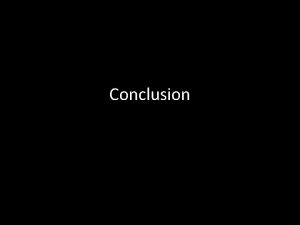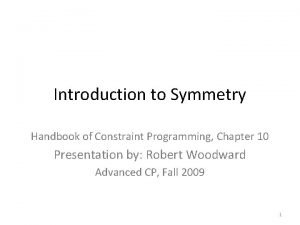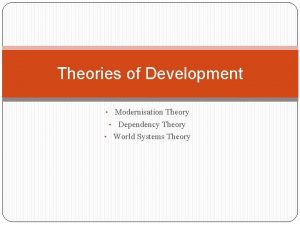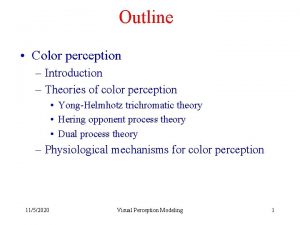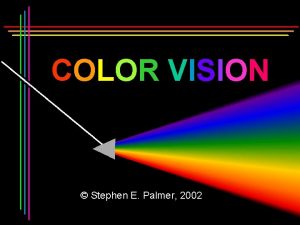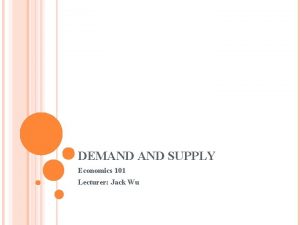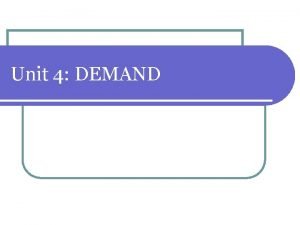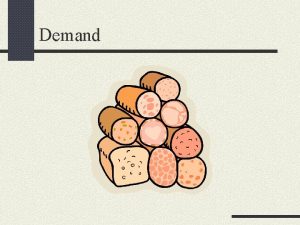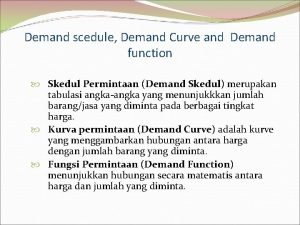Lecture 08 Theory of Demand conclusion Lecturer Martin






























































- Slides: 62

Lecture # 08 Theory of Demand (conclusion) Lecturer: Martin Paredes

1. 2. 3. 4. 5. Individual Demand Curves Income and Substitution Effects and the Slope of Demand Applications: the Work-Leisure Trade-off Consumer Surplus Constructing Aggregate Demand 2

Definition: The income-consumption curve of good X is the set of optimal baskets for every possible income level. l Assumes all other variables remain constant. 3

Y (units) I=40 U 1 0 10 X (units) 4

Y (units) I=68 I=40 U 1 0 10 18 U 2 X (units) 5

Y (units) I=92 I=68 U 3 I=40 U 1 0 10 18 U 2 24 X (units) 6

Y (units) I=92 Income consumption curve I=68 U 3 I=40 U 1 0 10 18 U 2 24 X (units) 7

Note: l The points on the income-consumption curve can be graphed as points on a shifting demand curve. 8

Y (units) I=40 0 Income consumption curve U 1 10 X (units) PX $2 I=40 10 X (units) 9

Y (units) I=68 I=40 0 Income consumption curve U 2 U 1 10 18 X (units) PX $2 I=68 I=40 10 18 X (units) 10

Y (units) I=92 I=68 I=40 0 U 3 Income consumption curve U 2 U 1 10 18 X (units) 24 PX $2 I=68 I=40 10 18 24 I=92 X (units) 11

l The income-consumption curve for good X can also be written as the quantity consumed of good X for any income level. ð This is the individual’s Engel curve for good X. 12

I (€) 40 0 10 X (units) 13

I (€) 68 40 0 10 18 X (units) 14

I (€) 92 68 40 0 10 18 24 X (units) 15

I (€) Engel Curve 92 68 40 0 10 18 24 X (units) 16

Note: l When the slope of the income-consumption curve is positive, then the slope of the Engel curve is also positive. 17

Normal Good: l If the income consumption curve shows that the consumer purchases more of good X as her income rises, good X is a normal good. l Equivalently, if the slope of the Engel curve is positive, the good is a normal good. 18

Inferior Good: l If the income consumption curve shows that the consumer purchases less of good X as her income rises, good X is a inferior good. l Equivalently, if the slope of the Engel curve is negative, the good is a normal good. Note: A good can be normal over some ranges of income, and inferior over others. 19

Y (units) Example: Backward Bending Engel Curve I=200 0 U 1 • 13 X (units) I (€) 200 • 13 X (units) 20

Y (units) Example: Backward Bending Engel Curve I=300 I=200 0 U 1 U 2 • • 13 18 X (units) I (€) 300 200 • 13 • 18 X (units) 21

Y (units) U 3 I=300 I=200 0 Example: Backward Bending Engel Curve I=400 U 1 • • • U 2 13 16 18 X (units) I (€) • 400 300 200 • • 13 16 18 X (units) 22

Y (units) U 3 I=300 I=200 0 Example: Backward Bending Engel Curve I=400 U 1 • • • Income consumption curve U 2 13 16 18 X (units) I (€) • 400 300 200 • • Engel Curve 13 16 18 X (units) 23

l There are two effects: 1. Income Effect 2. Substitution Effect 24

Definition: When the price of good X falls, purchasing power rises. This is called the income effect of a change in price. l l It assumes all else remain constant The income effect may be: 1. Positive (normal good) 2. Negative (inferior good). 25

Definition: When the price of good X falls, good X becomes cheaper relative to good Y. This change in relative prices alone causes the consumer to adjust his consumption basket. This effect is called the substitution effect. l It assumes all else remain constant l The substitution effect is always negative 26

Usually, a move along a demand curve will be composed of both effects. l Let’s analyze both effects for the cases of: l Normal good l Inferior good l 27

Y Example: Normal Good: Income and Substitution Effects BL 1 has slope -PX 1/PY A • U 1 0 XA X 28

Y Example: Normal Good: Income and Substitution Effects BL 2 has slope -PX 2/PY A • C • U 2 U 1 0 XA XC X 29

Y Example: Normal Good: Income and Substitution Effects A • C B • 0 XA XB • U 2 BLd has slope -PX 2/PY U 1 XC X 30

Y Example: Normal Good: Income and Substitution Effects Substitution Effect: XB-XA A • C B • 0 XA XB • U 2 U 1 XC X 31

Y Example: Normal Good: Income and Substitution Effects Substitution Effect: Income Effect: XB-XA XC-XB A • C B • 0 XA XB • U 2 U 1 XC X 32

Y Example: Normal Good: Income and Substitution Effects Substitution Effect: Income Effect: Overall Effect: XB-XA XC-XB XC-XA A • C B • 0 XA XB • U 2 U 1 XC X 33

Y Example: Inferior Good: Income and Substitution Effects BL 1 has slope -PX 1/PY A • U 1 0 XA X 34

Y Example: Inferior Good: Income and Substitution Effects C A • • U 2 BL 2 has slope -PX 2/PY U 1 0 XA XC X 35

Y Example: Inferior Good: Income and Substitution Effects C A • • B • 0 XA XC XB U 2 BLd has slope -PX 2/PY U 1 X 36

Y Example: Inferior Good: Income and Substitution Effects Substitution Effect: XB-XA C A • • B • 0 XA XC XB U 2 U 1 X 37

Y Example: Inferior Good: Income and Substitution Effects Substitution Effect: Income Effect: XB-XA XC-XB C A • • B • 0 XA XC XB U 2 U 1 X 38

Y Example: Inferior Good: Income and Substitution Effects Substitution Effect: Income Effect: Overall Effect: C A • • B • 0 XA XC XB XB-XA XC-XB XC-XA U 2 U 1 X 39

l l Theoretically, it is possible that, for an inferior good, the income effect dominates the substitution effect A Giffen good is a good that is so inferior, that the net effect of a decrease in the price of that good, all else constant, is a decrease in consumption of that good. 40

Y Example: Giffen Good: Income and Substitution Effects BL 1 has slope -PX 1/PY A • U 1 0 XA X 41

Y Example: Giffen Good: Income and Substitution Effects C • U 2 BL 2 has slope -PX 2/PY A • U 1 0 XC XA X 42

Y Example: Giffen Good: Income and Substitution Effects C • U 2 A • BLd has slope -PX 2/PY B • 0 XC XA XB U 1 X 43

Y Example: Giffen Good: Income and Substitution Effects C • Substitution Effect: Income Effect: Overall Effect: U 2 XB-XA XC-XB XC-XA A • B • 0 XC XA XB U 1 X 44

Notes: l For Giffen goods, demand does not slope down. l For the income effect to be large enough to offset the substitution effect, the good would have to represent a very large proportion of the budget. 45

Example: Finding Income and Substitution Effects Suppose a Quasilinear Utility: U(X, Y) = 2 X 0. 5 + Y => MUX = 1/X 0. 5 PY = € 1 I = € 10 MUY = 1 46

1. Suppose PX = € 0. 50 • Tangency condition: MUX = PX _1_ = 0. 5 XA = 4 MUY PY X 0. 5 • Budget constraint: PX. X + P Y. Y = I YA = 8 • Utility level: U* = 2 (4)0. 5 + 8 = 12 47

2. Suppose PX = € 0. 20 • Tangency condition: MUX = PX _1_ = 0. 2 XC = 25 MUY PY X 0. 5 • Budget constraint: PX. X + P Y. Y = I YC = 5 • Utility level: U* = 2 (25)0. 5 + 5 = 15 48

3. What are the substitution and income effects that result from the decline in PX? • Find the basket B that gives a utility level of U = 12 at prices PX = € 0. 20 and PY = € 1 49

Y Substitution Effect: Income Effect: Overall Effect: XB-XA XC-XB XC-XA A • C B • 0 XA=4 XB • U 2=15 U 1=12 XC=25 X 50

• • • Tangency condition: MUX = PX _1_ = 0. 2 XB = 25 MUY PY X 0. 5 Utility constraint: U* = 2 (25)0. 5 + Y = 12 YB = 2 Then: • Substitution Effect: • Income Effect: XB - XA = 25 - 4 = 21 XC - XB = 25 - 25 = 0 51

l l The individual’s demand curve can be interpreted as the maximum amount such individual is willing to pay for a good In turn, the market price determines the amount the individual actually pays for all the units consumed. 52

Definition: l The consumer surplus is the net economic benefit to the consumer due to a purchase of a good l It is measured by the difference between the maximum amount the consumer is willing to pay and the actual amount he pays for it. l The area under the ordinary demand curve and above the market price provides a measure of consumer surplus. 53

Example: Consumer Surplus • • Consider a Demand function: Q = 40 - 4 PX Suppose PX = € 3 • What is the consumer surplus? • First, at price PX = € 3 => Q = 28 54

PX Example: Consumer Surplus 10 X = 40 - 4 PX. . . Demand 40 X 55

PX Example: Consumer Surplus 10 3 28 40 X 56

PX Example: Consumer Surplus 10 Area = (0. 5) (10 -3) (28) = 98 G 3 28 40 X 57

PX 10 Example: Consumer Surplus What if PX = € 2? Area = (0. 5) (10 -2) (32) = 128 3 2 28 32 40 X 58

Definition: The market demand function is the horizontal sum of the demands of the individual consumers. l In other words, the market demand is obtained by adding the quantities demanded by the individuals at each price and plotting this total quantity for all possible prices. 59

Example: Suppose we have two consumers, as shown below: P 10 P Q = 10 - p Q = 20 - 5 p 4 Consumer 1 P Q Consumer 2 Q Q Market demand 60

1. Individual ordinary (uncompensated) demands are derived from the utility maximization problem of the consumer. 2. The optimal consumption basket for a utility maximizing consumer changes as prices change due to both income and substitution effects. 61

3. If income effects are strong enough, a price rise may result in increased consumption for an optimizing consumer. 4. Consumer surplus measures the net economic benefit of a purchase. 5. Market demand is the horizontal sum of the individual consumer demands for a particular good. 62
 Lecturer's name
Lecturer's name 01:640:244 lecture notes - lecture 15: plat, idah, farad
01:640:244 lecture notes - lecture 15: plat, idah, farad Physician associate lecturer
Physician associate lecturer Spe distinguished lecturer
Spe distinguished lecturer Good afternoon students
Good afternoon students Photography lecturer
Photography lecturer Lecturer in charge
Lecturer in charge Designation lecturer
Designation lecturer Designation of lecturer
Designation of lecturer Gcwak
Gcwak Lecturer name
Lecturer name Pearson lecturer resources
Pearson lecturer resources 140000/120
140000/120 Lector vs lecturer
Lector vs lecturer Lecturer in charge
Lecturer in charge Cfa lecturer handbook
Cfa lecturer handbook Lecturer asad ali
Lecturer asad ali Deterministic and stochastic inventory models
Deterministic and stochastic inventory models Measures to correct deficient demand
Measures to correct deficient demand Individual demand vs market demand
Individual demand vs market demand What is dependent demand inventory
What is dependent demand inventory Ang demand schedule ay isang
Ang demand schedule ay isang Independent demand inventory examples
Independent demand inventory examples Module 5 supply and demand introduction and demand
Module 5 supply and demand introduction and demand Methods of demand estimation in managerial economics
Methods of demand estimation in managerial economics Paradox of value
Paradox of value Independent demand inventory
Independent demand inventory Natural language processing nlp - theory lecture
Natural language processing nlp - theory lecture Decision theory lecture notes
Decision theory lecture notes Bayesian decision theory lecture notes
Bayesian decision theory lecture notes Natural language processing lecture notes
Natural language processing lecture notes Conclusion martin luther king
Conclusion martin luther king Supply and demand conclusion
Supply and demand conclusion Supply and demand conclusion
Supply and demand conclusion Conclusion of demand
Conclusion of demand Martin hoffman empathy theory health and social care
Martin hoffman empathy theory health and social care Gender schema theory martin and halverson
Gender schema theory martin and halverson Theory of demand
Theory of demand Liquidity preference theory of money demand
Liquidity preference theory of money demand Theory of demand
Theory of demand Double factoral terms of trade
Double factoral terms of trade Marginal resource cost
Marginal resource cost Conclusión conclusión
Conclusión conclusión Rasa theory finds its vedic root in
Rasa theory finds its vedic root in Robert gagne biography
Robert gagne biography Niels bohr conclusion
Niels bohr conclusion Game theory conclusion
Game theory conclusion Conclusion of piaget's theory
Conclusion of piaget's theory Conclusion of group theory
Conclusion of group theory A remarkable turnaround case study
A remarkable turnaround case study Continental drift vs plate tectonics
Continental drift vs plate tectonics Dependency theory
Dependency theory Sensation
Sensation Modernization theory vs dependency theory
Modernization theory vs dependency theory Plate tectonic theory vs continental drift
Plate tectonic theory vs continental drift Describe the trichromatic theory of color vision.
Describe the trichromatic theory of color vision. Neoclassical organization theory
Neoclassical organization theory Theory x and theory y of motivation
Theory x and theory y of motivation Hawthorne effect in business
Hawthorne effect in business Continuity theory vs activity theory
Continuity theory vs activity theory Continuity theory vs activity theory
Continuity theory vs activity theory Explain the keynesian theory of employment
Explain the keynesian theory of employment Opponent process theory vs trichromatic theory
Opponent process theory vs trichromatic theory














































